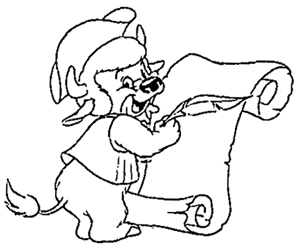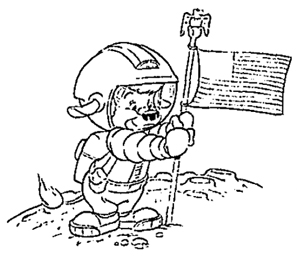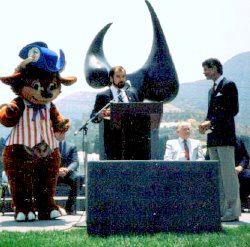Recently, as part of their “limited time magic” promo, Walt Disney World held an event which let guests mingle with “obscure” Disney characters. In the end the characters they featured were neither obscure or even particularly rare, but the concept in general is a good one. Disney history is littered with characters who were used for special events or were tied into films, television shows, or other properties that are long gone from the spotlight; characters appeared in the park for every animated feature from the 1980s and 1990s, but when was the last time you saw llama Kuzco or the cast of The Great Mouse Detective?
While they’re no longer marquee names, many of these characters are still loved by fans and are worth trotting out on occasion. Who wouldn’t want their pictures taken with the Rocketeer, or the DuckTales crew, or any of a hundred long-abandoned walkaround characters?
The forgotten Disney roster doesn’t end there, though. Aside from film and TV stars, Disney also has created many one-off characters for specific in-park uses or for special events or outside sponsors. Dreamfinder and Figment, as well as the recently-flourishing Orange Bird are famous examples of park-specific characters; don’t tell me there wouldn’t be a meet-n-greet queue if they were to return. Where is the line to meet the Kaiser Aluminum Pig? Outside of the parks were a slew of others, many long forgotten, including Andy Anaheim and the 1984 Summer Olympics mascot, Sam the Eagle.
Occasionally, though, no matter how much of a nerd you are for these obscurities, you find something that you’ve never heard of. Something that somehow flew under your radar. Something so bizarre and amazing that it quickly becomes one of The Best Things Ever.
Something – someone – like Bisontennial Ben.
Bisontennial Ben.
Bisontennial Ben.
But of course! Don’t you remember Bisontennial Ben, the Disney-created mascot of the 1987 bicentennial of the American Constitution? The triple-pun combination of a buffalo and founding father Benjamin Franklin who appeared at a variety of events, including the 1988 Tournament of Roses Parade alongside Muhammad Ali and Buzz Aldrin? Of course you remember!
Ok, I totally didn’t remember. But it blows my mind.
While most fans are aware that Disney threw a massive Bicentennial celebration at Disneyland and Walt Disney World in 1976, many people today have forgotten that they also tried to make an event of the 1987 Constitutional Bicentennial. The massive “Spirit of America” parade appeared daily at the Magic Kingdom, and a series of events were held throughout the year to mark the occasion.
At a media event in 1986, which kicked off Walt Disney World’s 15th anniversary, former Supreme Court Chief Justice Warren Burger appeared to speak about the upcoming bicentennial celebrations. Burger, chairman of the Commission on the Bicentennial of the U.S. Constitution, appeared alongside journalist Nicholas Daniloff, who had just been freed from a KGB prison in the Soviet Union.
Burger even provided the pre-recorded introduction to America the Musical Salutes the Spirit of America, a stage show which was performed daily in front of Cinderella Castle. Starring Mickey, Minnie, Goofy, Pluto, Donald, Chip and Dale, and the Country Bears, alongside the usual lineup of singers and dancers, the show featured fireworks and the release of 200 doves, a salute to the armed forces, and, amazingly, a recitation of the Constitutional preamble by the characters. It ended with Mickey, Donald, and Goofy appearing as the “Spirit of ’76”, a visual familiar from 1976’s “America on Parade”.
“Yes, yes,” you say, “but what about Bisontennial Ben?”
Bisontennial Ben was created by the Creative Resources department of Disney Consumer Products, and offered to the national Bicentennial commission. When the federal commission passed on the design, it was adopted by the California Bicentennial Association for their own four-year celebration of the event.
The “robust” bison was chosen “because of his historic significance and air of dignity, strength and endurance,” according to Disney. The character was meant to resemble founder Benjamin Franklin, with his trademark (non-rose-colored) bifocals, and often appeared with a quill pen in hand, just in case there were any historical documents that needed signing. He was announced in 1987, and slated to appear “throughout the year at many of the events currently being planned by the California Bicentennial Foundation, including a number of corporate-sponsored activities.” Further plans included his appearance on a variety of merchandise commemorating the event.
Bisontennial Ben was created at the behest of the improbably-named Peter Paul, an entrepreneur and, shall we say, “promoter”, who was the executive vice president of the California Bicentennial Foundation. “We are making the Constitution user-friendly,” said Paul at the time. “We have taken California innovation and creativity and directed them to selling an important message.”
This impetus for showmanship had drawn a fair bit of criticism for the California commission. Initiated and funded by the state legislature, the Foundation had seen its state funding revoked in 1987 when three of its commissioners were forced to resign after they approved the publication of a book, “The Making of America”, which contained racist elements. State Senator Gary Hart, who had supported the creation of the Foundation in 1984, led the fight to defund it in 1987. Further attacks came from state officials and former commission members, who felt that the Foundation had lost its educational focus and had become fixated on showmanship and the sales of thousands of Bicentennial gold and silver coins, t-shirts, bumper stickers, balloons and buttons.
Paul insisted it was all part of promoting the Constitutional message, although even his defenses drew criticism. “We’re using the same people who sell soap to sell understanding of the Constitution,” he told the media; this and other comments, as well as Bisontennial Ben himself, drew criticism from some of the more stodgy letter-writers to the Los Angeles Times.
The Foundation claimed that all the pizzazz was necessary to give California’s celebrations their own unique identity, and that the western state didn’t have a deep history and ties to colonial times like the east-coast colonies. They intended to stray far from “fife and drum” type shows, as they coordinated with groups to sponsor speeches, parades, essay contests, concerts and fireworks in more than a hundred California towns. “If you had a reenactment of 39 sweaty old men arguing in Philadelphia, how many of our children would be interested?” said Paul. “But put them in space suits, and the kids will really go for it.”
This rather gonzo attitude can be seen in the events planned for September 17, 1987, the actual anniversary of the Constitutional signing. As described in the Los Angeles Times, the Foundation’s events were to go something like this:
The day would begin at Seal Beach, where Bisontennial Ben and Apollo astronaut Buzz Aldrin would plant a Bicentennial flag in the sand as a live band played and an Air Force jet squadron flew overhead. Aldrin would then depart by helicopter for Beverly Hills, where he would tour local schools. Later, everyone would travel to Knott’s Berry Farm, where, at the park’s re-creation of Philadelphia’s Independence Hall, California Chief Justice Malcolm Lucas would symbolically sign a copy of the Constitution. Lucas would be joined by Aldrin and “celebrities, dancers, movie stars, and Olympians”, as well as 100 “resident aliens”. After the immigrants were sworn in as American citizens, Helen Reddy would sing “America the Beautiful” and, at 1 p.m., a replica of the Liberty Bell would be rung for 200 seconds.
The last appearance of Bisontennial Ben I can find was in January of 1988, when he appeared on the Foundation’s float in the Tournament of Roses Parade, taking his place beside Aldrin and Ali.

Peter Paul, Buzz Aldrin, Mickey Mouse, Muhammad Ali, and Bisontennial Ben appear alongside a model of “Communicating Freedom”, the California Bicentennial Foundation’s float for the 1988 Tournament of Roses Parade.
Two “civilians” also appeared on the float, selected from 3,000 submitted names. Sara Beth Heller, a 7-year-old from Lancaster, Pennsylvania, and 81-year-old Herbert Blackburn of North Las Vegas, Nevada, were picked to ride after, according to the Los Angeles Times, a “computer, a Boy Scout, and the organization’s buffalo-robed mascot, ‘Bisontennial Ben,’ narrowed down the list on the Big Spin lottery show.”
And so ends the tale of Bisontennial Ben… almost.
In researching this saga, what appeared at first to be a brief postscript to the story wound up being a bizarre series of events that, 25 years after Bisontennial Ben’s celebration, wound up tying right back into modern day Disney-related news.
It all has to do with Peter F. Paul, the aforementioned executive of the California Bicentennial Foundation. As you can see from his website, he seems to be one of those guys who is constantly getting involved with different causes and fundraisers in order to get his picture taken with various celebrities and politicians. One imagines his office is lined, wall to wall, with autographed photos of him with people who don’t quite remember remember meeting him in any of a million handshake lines. He’s a promoter, and an almost Zelig-like figure with quite a history.
A lawyer and “entrepreneur”, Paul has been convicted several times on charges ranging from drug dealing to securities fraud. In the 1970s, he led a scam which sought to defraud the Cuban government, which he would later claim was intended to be anti-Communist activity. In reality, he sold agents of Fidel Castro $8.75 million in nonexistent coffee, and then sought to sink a cargo ship to cover up the crime and, incidentally, defraud the ship’s insurer. The plan fell through when the erstwhile saboteurs missed the boat, and Paul was arrested. When police went to search his house, they found a garage full of cocaine; Paul was indicted and found guilty of federal conspiracy charges as well as possession of cocaine with intent to distribute.
After getting out of prison, Paul traveled to Canada in 1983 with a false ID; this was not only a crime but a violation of his parole, and he went back to prison. In 1985 he was out again, and wound up being an executive of the California Bicentennial Foundation for the Constitution and Bill of Rights. He tried to involve himself with politicians and celebrities; he served for a time as Fabio’s agent.
In 2000, he became a major fundraiser for Hillary Clinton’s Senate campaign, seeking to buy favors and perhaps a pardon for his crimes. He put together a huge fundraising gala in Los Angeles, using money that he had fraudulently borrowed from Merrill Lynch. When the Clinton campaign found out about his background they returned his donations, and he spent much of the next decade in a series of nuisance lawsuits against Clinton, her campaign, and even the Federal Election Commission. He became a darling of the far-right fringe for his attacks on the Clintons, although he eventually turned on his arch-conservative backers and filed suit against them as well. These lawsuits found little traction, as most of them were filed while Paul himself was in Brazil, where he was fleeing extradition for a variety of federal criminal charges.
This is where it gets back around to Disney.
In 1998, Paul co-founded the internet startup Stan Lee Media, alongside legendary comic creator Stan Lee. The internet media company ran out of money during the dot-com bust of 2000; Paul blamed Bill Clinton for the failure, and filed suit against him, but it turned out that Paul and another of the company’s executives had illegally tried to bolster the company’s stock price by fraudulently buying stock with bad checks. Stan Lee Media went bankrupt in 2001, and Paul fled to Brazil.
He was finally extradited in 2003, and charged with securities fraud and a range of civil suits. He’s currently in federal prison. But he has continued to file a slew of lawsuits against Lee, Lee’s family, Marvel, and other Marvel executives, claiming that he actually owns the rights to all of Lee’s famous comic creations due to their former partnership in Stan Lee Media. He has even accused Lee of colluding with the Clintons. And, as you might have seen, he filed a multi-billion-dollar lawsuit against The Walt Disney Company in October 2012 stating again that he owns the rights to all of Lee’s Marvel characters and is therefore owed for all of Disney’s recent cinematic superhero successes. It’s a lawsuit that Disney continues to fight as of this writing.
And that, as the man once said, is the rest of the story.
Of course, the only obvious outcome which could square this circle of historical randomness is for Bisontennial Ben to become part of the Marvel Cinematic Universe. Maybe he could appear in Avengers 2! He should at least get to audition for Rocket Raccoon in Guardians of the Galaxy. And, hopefully, his costume is in the back of a closet somewhere, ready to be taken out of mothballs for a future round of “limited time magic”.
Bisontennial Ben, y’all.














Michael: Where DO you get this stuff? Amazing. If it weren’t for the photos, I’d swear you’re making this story up…if just for the pun alone.
Love the obscure stuff! Thanks for digging.
Rob
Thanks! This was one of those where you find some fact and your mind is just blown. I found a reference to Bisontennial Ben in an old news article and immediately had find out everything I possibly could. And the more you find out, the more insane the story gets. I can’t believe this was a real thing.
One again you have come up with amazing, hidden stories! How do you know to look?? and 2 stories for the price of one.
I was really hoping you were gonna say Paul was the guy inside the Bisontennial Ben suit.
thank you for finding and preparing this – love your work! Way better than the average bison ….oops bear
Wow. Just, wow.
(web link is from January, 1988)
Ho-lee Crap. This is truly an amazing story. Mind = blown
Incidentally- I wish professional journalists actually did this level of investigative journalism. Really amazing what you managed to turn up.
[…] Bisontennial Ben. A blog post at Progresscityusa.com that must be read to be believed. […]
What in the world.
Holy crud, you’re amazing! What a great story!
Everything about this article is AMAZING. Everything.
It’s like Schoolhouse Rock, as produced by John DeLorean.